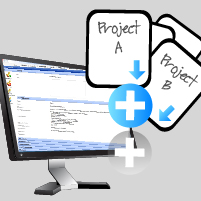As discussed in our first blog post (Part I) on this topic, we’re often asked when the best time is to add projects to PPO. The fact of the matter is that there is no “cut and dried” answer to this question, as it mostly depends on the origin of the project; something that is very much based on your type of business.
In this follow-up blog post, we cover the scenario of an internal corporate project office, following on from our previous article, which discussed professional services companies specifically. If you missed that one, read it here.
In an internal corporate project office, projects normally initially originate from a strategic planning cycle. For companies with a strong portfolio management process, the very definition of your strategy will lead to a planning cycle that will cascade this strategy into portfolios, programmes and, ultimately, projects to be executed in order to meet strategic objectives.
This process normally takes place every few years, with smaller planning cycles annually to review the existing portfolio and realign projects required. While the flow of new projects should ideally be easy to manage, an internal need to execute projects to support the “business as usual” portfolio unfortunately exists in most cases. These projects originate on an ad-hoc basis and are usually the problem originators when it comes to figuring out when to add them to PPO.
Our recommendation is that strategic projects should be added to PPO as soon as possible to provide a full context view of the portfolio, its programmes and, most importantly, the projects that need to be executed. Loading these into PPO from the beginning will provide a holistic portfolio view to the EXCO and management team and not just the projects that are currently active.
During the course of the year, the views will allow for a reminder of all projects that need to be completed. A number of companies are currently using PPO to accomplish this successfully and have even gone as far as defining the planned start and end dates, budgets and, in some cases, the stakeholders that would be involved. The configuration of PPO normally allows for a project status of “Proposed” and a phase prior to the first project phase (typically “Pre-Initiation” or “Justification”). In this way, the entire planned portfolio can be loaded into PPO and, as each project is initiated, the status is changed to “Active” and the phase changed to “Initiation”. Then only can the project be managed on PPO following the prescribed methodology.
While this works well for the strategic portfolio, it’s very common that new projects will be required during the course of the year to support the strategic portfolio or to day-to-day business operations. These projects might require a business case and, based on the strength of the business case, would be approved and activated. So, when should you load these projects? Once the business case has been approved, while the business case is being produced, or when the initial idea or demand was identified?
We recommend that they should be loaded as soon as the idea or demand is identified. Once again, they should be loaded into the “Proposed” status and “Justification” or “Pre-Initiation” phase to allow for easy filtering on the active vs. proposed projects.
The key reasons and benefits for recording these projects early on PPO are:
- The ability to track total effort: If you’re using the timesheet functionality in PPO, then having the projects loaded before the business cases are completed will allow resources to log time against these projects. In turn, this will provide an important metric of the time spent on working on business cases and potential projects.
- Visibility of all pre-project work: In some cases, key resources will spend a large amount of time on pre-project work to assist with the formulation of business cases. Having these projects available in PPO provides visibility of the number of initiatives that are currently being worked on and, most importantly, if the business cases are delayed or rejected, this information is available in PPO. Recording the rejected business cases, including the reasons for the rejection, will assist in completing a repository of business cases, which can be revisited from time to time when new business cases are required.
- The collection of documentation and information: When the project is raised on PPO from the beginning, all documentation that is used and created during the process of completing the business case can be stored and recorded on PPO. Any issues, risks or important information available during this process can be loaded and tracked on PPO, providing a complete audit trail and history to the project team when the project begins.
Fortunately, this configuration is already available in our pre-configured project management office solution. So, if you need to track all your projects, try a free 30-day trial of Project Portfolio Office’s (PPO) professional services solution today at https://www.go2ppo.com/free-trial/.
PPO is an award winning online project portfolio management and collaboration application. PPO is simple, immediate, secure and affordable. PPO is flexible and can be configured to support any methodology.



